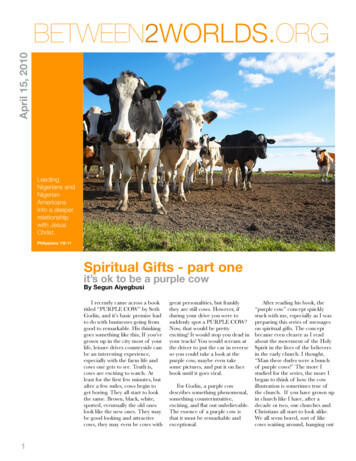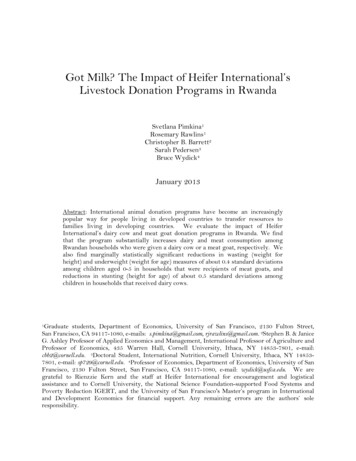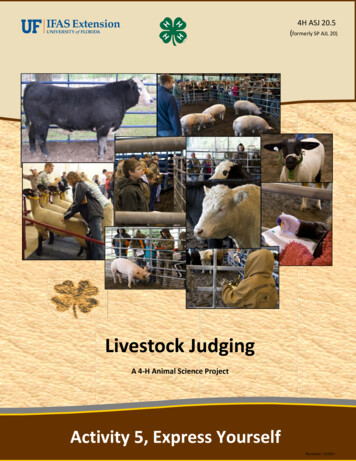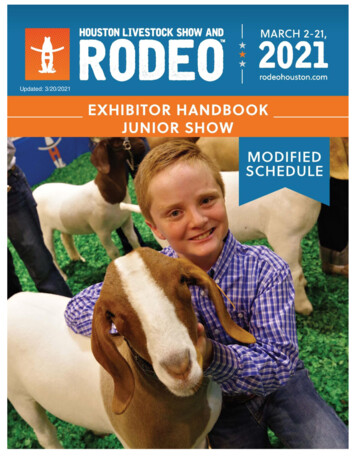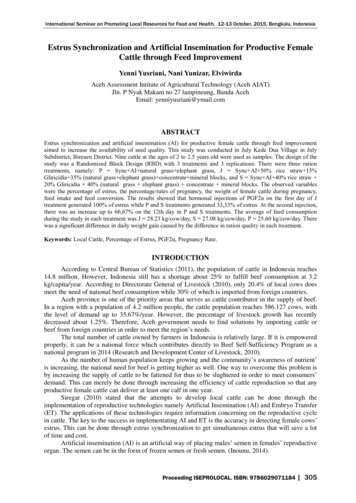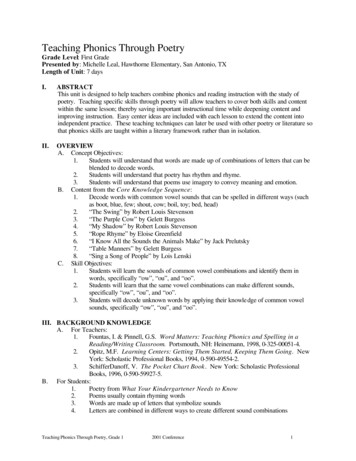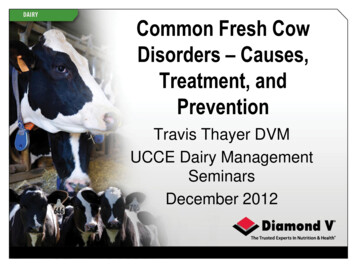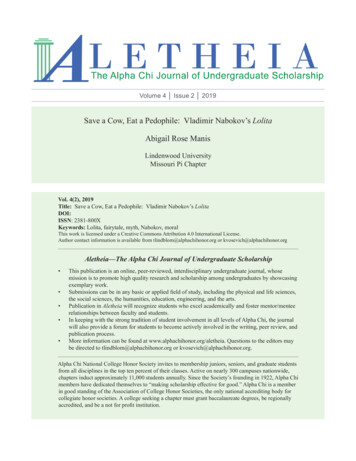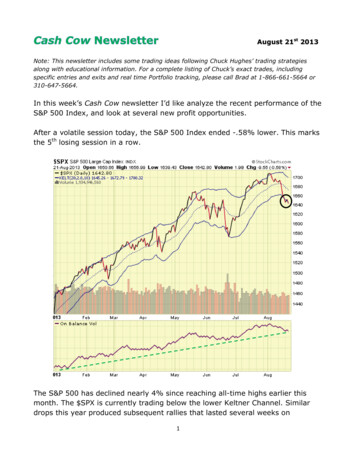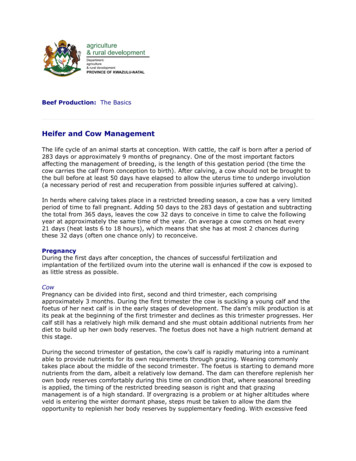
Transcription
Beef Production: The BasicsHeifer and Cow ManagementThe life cycle of an animal starts at conception. With cattle, the calf is born after a period of283 days or approximately 9 months of pregnancy. One of the most important factorsaffecting the management of breeding, is the length of this gestation period (the time thecow carries the calf from conception to birth). After calving, a cow should not be brought tothe bull before at least 50 days have elapsed to allow the uterus time to undergo involution(a necessary period of rest and recuperation from possible injuries suffered at calving).In herds where calving takes place in a restricted breeding season, a cow has a very limitedperiod of time to fall pregnant. Adding 50 days to the 283 days of gestation and subtractingthe total from 365 days, leaves the cow 32 days to conceive in time to calve the followingyear at approximately the same time of the year. On average a cow comes on heat every21 days (heat lasts 6 to 18 hours), which means that she has at most 2 chances duringthese 32 days (often one chance only) to reconceive.PregnancyDuring the first days after conception, the chances of successful fertilization andimplantation of the fertilized ovum into the uterine wall is enhanced if the cow is exposed toas little stress as possible.CowPregnancy can be divided into first, second and third trimester, each comprisingapproximately 3 months. During the first trimester the cow is suckling a young calf and thefoetus of her next calf is in the early stages of development. The dam's milk production is atits peak at the beginning of the first trimester and declines as this trimester progresses. Hercalf still has a relatively high milk demand and she must obtain additional nutrients from herdiet to build up her own body reserves. The foetus does not have a high nutrient demand atthis stage.During the second trimester of gestation, the cow’s calf is rapidly maturing into a ruminantable to provide nutrients for its own requirements through grazing. Weaning commonlytakes place about the middle of the second trimester. The foetus is starting to demand morenutrients from the dam, albeit a relatively low demand. The dam can therefore replenish herown body reserves comfortably during this time on condition that, where seasonal breedingis applied, the timing of the restricted breeding season is right and that grazingmanagement is of a high standard. If overgrazing is a problem or at higher altitudes whereveld is entering the winter dormant phase, steps must be taken to allow the dam theopportunity to replenish her body reserves by supplementary feeding. With excessive feed
shortages, such as during a drought, early weaning of the calf towards the end of the firsttrimester should be considered to prevent an excessive loss of body condition in the dam.Foetal growth during the third trimester of pregnancy is very rapid and consequently thereis a high demand for nutrients from the cow. Should a cow’s current calf be left with her,although milk production is rapidly declining, there is an unnecessary drain on the dam’snutrient resources. With seasonal breeding, especially in sourveld areas, the availability ofnutrients from natural grazing lands is declining or very low when the cow is in the thirdtrimester of pregnancy. Supplementary feeding is often essential. However, excessivefeeding, resulting in gross fat deposition, should be avoided. A period of at least 6 weeksduring which the dam does not suckle a calf will allow her udder a period of rest duringwhich time involution of the udder tissue will ensure a good milk supply for the next calf.HeiferPregnancy in heifers follows the same pattern as in cows, except that the heifer does notrequire nutrients for milk production, and with heifers there is also a need to provideadditional energy and protein for the heifer herself to grow to full maturity. Heifers thathave been bred at a relatively light weight (60% of mature live mass), have a much higherdemand for nutrients for growth than heifers bred at a higher live mass (80% to 90% ofmature live mass). With most breeds of cattle, cows do not achieve full mature size before 4to 5 years of age, which coincides with the weaning of their second calf. Heifers as well asfirst calvers therefore need good nutrition and extra care if the intention is to have maturecows which have grown out to their full genetic potential for size.CalvingUnder extensive beef production systems, there is a need for "no-nonsense" cows i.e. cowsthat can calve without assistance. Discussions on how to help with calving difficulties istherefore aimed at reducing losses rather than promoting the retention of problem cows.When a cow is assisted, both the cow and the calf must be marked for culling.Enlarging of the udder, loosening of the ligaments around the tail root and oedema(swelling) of the vulva are signs that a cow is nearing the time to calve down (parturition).Cows often move away from the main herd as they near parturition. Some cows, especiallyheifers and high milk producers, are prone to severe swelling of the udder, which isuncomfortable and even painful to the cow. In extreme cases it might be necessary to milkthe dam before the birth of the calf to relieve some of the discomfort. Should it benecessary to milk the cow before the calf is born, it is advisable to keep some colostrum tofeed to the calf after birth (post partum).Some heifers and young cows tend to develop oedema (swelling) in the area between theudder and the umbilicus before calving. Post partum, once the calf commences suckling,this oedema usually disappears without any adverse side effects.
Figure 1. During the initial phases of calving, the fluid filled foetal membranes appear.During the initial stages of parturition (calving), the cervical opening enlarges, a necessaryprocess to allow the calf to be born. Unless the cow is examined internally, distention of theendo-cervical channel cannot be seen. After a time, the foetal membranes appear (Figure1).Cows close to calving should not be disturbed as they tend to try and delay calving whenthere are strangers nearby or when they are exposed to abnormal environmentalconditions.Figure 2. With normal presentation, the front feet and head usually appear first.
Figure 3. A cow usually lies down during the latter stages of calving when the calf isejected, although some stand up, allowing the calf to drop to the ground.Should the front legs and head of a calf not appear first (Figure 2 &3), the dam must bemonitored to ensure that an abnormal presentation (e.g. hind quarter of the calf appearingfirst) does not prevent her from delivering the calf or that an extended birth period tires herand the calf unnecessarily. The inclination to assist with birth is natural, but premature aidmasks cows prone to calving difficulties and should therefore be avoided.After calving, a cow will lick her calf (Figure 4) and eat the afterbirth, which is usuallypushed out soon after birth. Eating the afterbirth is a natural process and must not bediscouraged because the afterbirth serves as a valuable source of nutrients for the cow.Where cows do not eat the afterbirth or leave pieces of it behind, these should ideally beburied to prevent the spread of disease.Should the afterbirth remain in the uterus i.e. the afterbirth is retained, it is better not to tryand remove it forcibly. If long pieces of afterbirth are hanging out and are in danger ofbeing trampled on by the cow, the pieces hanging down can be cut off at the level of thehocks. Daily treatment with pessaries will prevent infections and the cow can be left for 3 to4 days to eject the afterbirth on her own, or allow the afterbirth to loosen before steps aretaken to remove it. When pessaries are placed into the uterus, the membranes can belightly pulled ("milked"), but tearing must be avoided. With difficult calving or retainedafterbirth, treatment for the prevention of uterine infections must be applied. Uterinepessaries can be put into the uterus until the cervical opening closes, after which a pipetteis used to deposit disinfectants in the uterus.
Figure 4. The dam licking her calf after birth.Healthy calves usually start to try to stand up within minutes after the dam has startedlicking it and will then try to suckle. Experienced and good dams usually encourage the calfto suckle. Should the dam prevent the calf from suckling or her udder be so swollen that thecalf has difficulty suckling, assistance must be provided. The objective is to ensure that thecalf ingests enough colostrum within 4 hours post partum. A calf needs a minimum of 4 Rcolostrum. Although many heifers are instinctively good mothers, some are not. Udders areprone to tenderness post partum, especially in heifers, inciting them to avoid efforts by thecalf to suckle.Heifer matingHeifers are usually mated at either 15 or 27 months to calve down for the first time at 2 or3 years respectively. As a rule of thumb, heifers should first be mated when they weigh atleast 60% of mature mass. The age at which this target mass is reached will differdepending on level of nutrition (amount and type of feed available), breed, the age at whichshe cuts teeth and the time of year she was born.First calf cows (i.e. heifers that have calved and are brought to the bull for the second time;by definition, a heifer becomes a cow at the birth of her first calf), have notoriously lowconception rates, partly as a result of the fact that the intercalving period between the firstand second calf has been shown world-wide to be longer than subsequent intercalvingperiods. Inadequate nutrition is probably a contributory cause of the extended first intercalving period. One of the strategies advised to overcome this difficulty is to breed heifers 4to 6 weeks before the main herd. This practice compensates for the extended firstintercalving period and allows extra time between the first and second calf for the dam tobuild up body reserves as well as grow. It has been demonstrated that conception rates infirst calvers can be improved by breeding heifers ahead of the main herd, avoiding theimprudent loss of good genetic material where there is a policy to cull all skips (cowsdiagnosed non-pregnant at the time of pregnancy diagnosis).Where first calvers are run with the mature cows and/or if calves of first calvers are notweaned before the main herd, the practice of mating heifers ahead of the mature cows doesnot achieve its aim of improving conception rates in first calvers. If anything, failing to weancalves from heifers mated earlier, places additional stress on animals still in their growing
phase. Another problem with breeding heifers ahead of the main breeding season is that thebreeding season is timed to synchronise the available fodder production with the feedneedof the mature cows. By breeding heifers earlier, their nutrient requirements are notmatched to the fodder production of the farm unless supplemental feed for the heifers isprovided. In practice it could be better to breed heifers with the main herd and at the sametime ensure that there is adequate feed for all the animals on the farm. Where heifers aremated with the main breeding herd, more heifers must be retained annually to compensatefor the additional loss of first calvers that do not re-conceive.Keeping heifers and first calvers in separate herds allows younger, growing animals accessto better quality feed and an equal opportunity to reach feed or lick troughs.OvermatingThe aim of overmating is to ensure that only pregnant heifers are used as replacements. Inmost beef herds, between 15% and 25% of cows are culled each year and must bereplaced. With theoretical stock flow calculations, 20% is commonly taken as thereplacement rate, whereas 16% of mature cows are replaced annually in commercialextensively farmed cattle herds in KwaZulu-Natal. With overmating, 20% to 30% moreheifers than the number needed for replacement, are mated and kept as replacementheifers. Thus, if 20 replacements are needed for a 100 cow herd, 25 heifers are mated andthe following year 20 are selected as replacements.Cow and heifer selectionWith beef herds, replacement heifers are selected from the calf crop each year and, up tothe time that they are mature animals and calve down themselves, further selection takesplace from time to time. Although heifers considered less desirable are culled, it can be saidthat with heifers the emphasis is selecting for desired traits, whereas with cows theemphasis is on culling poor doers.Selecting heifers and culling cows in a beef herd must be based on the goals set for therelevant enterprise but some factors are important irrespective of goals. These include: Fertility. Reproductive rate (number of calves born in relation to the number of cowsbred) is the most important factor determining economic efficiency in a beef herdand is dependent on cow fertility, which in turn is highly dependent on nutrition.Fertility has been shown to have a low heritability and is therefore a trait that doesnot respond rapidly to selection. Cows that do not reconceive are unproductive and aburden to the beef enterprise. However, before deciding to cull a cow for not fallingpregnant during the breeding season, the situation must be evaluated with care. It isnoteworthy that pregnancy is an all or nothing event and research has shown thatskip cows have a high probability of conceiving in the subsequent breeding season(Table 2). Non-conception can be caused by a number of factors, including poornutrition, bull infertility, poor management, uterine infections etc. To avoid theneedless loss of productive breeding animals, cows must only be held responsible fornot falling pregnant if it is certain that they are at fault. A good practice is to allow acow one skip in her life time, excluding skips that could be attributed to othercauses. The objective is to reduce the number of first calvers in a herd and toincrease the proportion of mature cows producing calves each year.Adaptation to local environment. Although adaptation is one of the most importantfactors affecting efficient production, there is no simple measure, except farmerexperience, to determine environmental adaptation.Quality of calf. Calves are selected annually as replacements for a breeding herd andthe remainder divided into groups which are sold according to quality. Should a cow
regularly produce a weaner that does not adhere to the requirements of theenterprise, she should be considered for culling.Age. Older cows tend to produce calves that are poor performers because the dam isno longer able to supply sufficient milk for the calf to grow well. Worn teeth,preventing the dam from grazing efficiently, is the most common cause of poor calfgrowth rate during the first 100 days of existence. Regular mouthing of cows willkeep the farmer informed as to the dental status of his breeding herd. Underconditions where cattle graze coarse grass or there is a lot of sand adhering to theirfodder, teeth tend to wear faster and culling rate in the herd is high. In areas wheredental wear is relatively intense, the productive life expectancy of cows is 8 to 10years. On the other hand, in some areas cows as old as 18 years have only moderatedental wear and are still highly productive.Conformation. It is accepted practice to use conformation as one of the selectionparameters for heifers. However, some defects only appear at a later age, forexample poor udder conformation cannot be evaluated in a heifer. As a cow ages,weaknesses in udder conformation are apt to be revealed, as well as problems suchas weak legs. A mistake often made is to assume that udder conformation is onlyimportant in dairy herds. In many beef herds where udder conformation wasignored, many new-born calves have to be assisted to suckle for some days andeven weeks, placing a demand on labour requirements.Injury. Where injuries to cows cause functional defects, they must be culled.Table 2. The performance of breeding females in a beef herd during the subsequentseason.Cow typeOpen cow (skip)PregnantFirst calver3yr old heifer2yr old heiferCalving rateDays frombulls in 13320303315201192179188177165151110164133In practice, all the animals in a beef herd are evaluated at some time during the year,usually at weaning (autumn in spring calving systems). At the same time an assessment ismade as to how many cattle can be kept on the farm, which depends on the available feed(grazing) and the number of cattle the farmer needs to sell for financial reasons. Based onthe evaluation and the weaning rate in the herd, the following is known: the number of replacement heifers (two-year old heifers of a desirable type) that areavailable for breeding during the subsequent breeding seasonthe number of yearling and weaner heifers of a desirable type in the herd(replacement heifers)the number of cull two-year old, yearling and weaner heifers in the herdhow many cull cows there are (i.e. the totally unproductive animals)and how many top (or most desired) cows there are in the herd.With reference to quality, there is usually a group of "middle cows" between the cull cowsand the top cows. The middle cows have to be evaluated with care. They are animals that
have some defects, but are still fully functional breeding animals able to produce a calf. Thedifficulty is that should the decision be taken to cull middle cows, they must be replacedwith pregnant heifers who have yet to prove themselves. It is known that the productionlevel of the calves from heifers is lower than that of mature cows. According to a number ofstudies, the weaning mass of calves from heifers was 15% to 20% lower than the weaningmass of calves from mature dams, which means that the quality of the replacement heifersmust be appreciably better than that of the middle cows they are to replace. Furthermore, ahigher percentage of replacement heifers in a breeding herd results in a higher percentageof first calvers in a herd. The problem is intensified by the difficulty of comparing old cowswith young heifers. Other factors that warrant consideration include: the potential selling price of older cows versus pregnant heifersthe farmer's financial statusthe season (e.g. available fodder for wintering in sourveld areas; grazing availableduring the dry season in sweetveld areas)replacement rate in subsequent seasons. Thus, in an expanding herd, more cows andreplacement heifers should be kept if there are few acceptable weaner and yearlingheifers.Taking all these factors into consideration, the decision must be taken as to which animalswill be kept and the remainder marked as culls which will be sold. The cull animals mustleave the farm immediately unless there is enough feed to keep them for fattening or to sellat a more opportune time when beef prices are at an optimum. On the other hand, it canhappen that the farmer carries little or no debt, that beef prices are relatively low andfodder is plentiful because of a good season, in which case cull two-year old, yearling andweaner heifers can be re-considered for keeping one more year. Cull two-year old heiferscan even be bred to provide additional calves the following summer. It is noteworthy thatcull cows are a liability and must be sold in any event.Heifer selectionHeifer selection is one of the most important tasks a beef farmer must perform because thetype of heifer selected will determine the type of cow comprising the breeding herd.Deferring heifer selection as long as possible assists in accuracy of selection. Thus, if allheifers could be kept until they have produced their first calves and the calves evaluated,heifers can be selected on the quality of their first calf. This practice is usually not practicaland reliance must be placed on selection based on the heifers own performance, theperformance of her parents and her conformation. Factors that can be considered in heiferselection include: Functional deficiencies. There are many functional deficiencies, of which themost common are wry face and poor leg structures.Inability to conceive. Heifers should be put to the bull and all that do notconceive within a short breeding season, should be culled.Genetic defects can be tested for at a nominal cost, including the relativelycommon Robertsonian 1/29 translocation.The farmer's breeding and production goals will determine a number ofselection criteria.With cattle breeding, selection criteria should not be too harsh because it has beendemonstrated that strict selection has the effect of narrowing down a gene pool. Selectioncriteria should be clearly defined and in choosing them, only proven selection criteriawarrant consideration.
heifers that have calved and are brought to the bull for the second time; by definition, a heifer becomes a cow at the birth of her first calf), have notoriously low conception rates, partly as a result of the fact that the intercalving period between the first and second calf has been shown world-wide to be longer than subsequent intercalving
